Leveraging Crowdsourcing for Mapping Mobility Restrictions in Data-Limited Regions
Abstract
:Highlights
- Developed a novel methodology for real-time mapping of mobility restrictions using spatial crowdsourcing and Telegram in data-limited regions.
- Achieved validation rates (67–100%) and precision (73%) for traffic event data collected and analyzed through this methodology.
- Enhanced traffic management and informed decision-making in regions with limited traditional data collection infrastructure.
- Provided a scalable model that can be applied to other regions with similar data limitations, contributing to the field of smart city technologies.
Abstract
1. Introduction
2. Mobility Restrictions in the Palestinian Territories, West Bank (WB)
3. Materials and Methods
3.1. Data Collection: Mobility Restriction Detection and Identification
3.1.1. Data Transmitted from Travelers Using Survey123
3.1.2. Data Retrieved from Telegram
3.2. Data Processing and Analysis
3.2.1. Telegram Data Processing
3.2.2. Telegram Data Analysis
3.2.3. Geocoding Mobility Restrictions Mined from Telegram Data
3.3. Mapping and Visualizing Mobility Restrictions to the End-Users
- Mapping mobility restrictions transmitted from travelers
- ii
- Mapping mobility restrictions mined from Telegram data
4. Data Quality Validation Methods
4.1. Validation of Crowdsourcing Data
4.2. Validation of Telegram Data
5. Results and Discussion
5.1. Mapping of Mobility Restriction Using Crowdsourced Data
5.2. Mapping Mobility Restriction Using Telegram Data
5.2.1. Validation of 3W Model
5.2.2. Validation of Restrictions Geocoding
6. Conclusions
Author Contributions
Funding
Data Availability Statement
Conflicts of Interest
References
- Hamrouni, A.; Ghazzai, H.; Frikha, M.; Massoud, Y. A Photo-Based Mobile Crowdsourcing Framework for Event Reporting. In Proceedings of the 2019 IEEE 62nd International Midwest Symposium on Circuits and Systems (MWSCAS), Dallas, TX, USA, 4–7 August 2019; pp. 198–202. [Google Scholar] [CrossRef]
- Zuo, F.; Kurkcu, A.; Ozbay, K.; Gao, J. Crowdsourcing Incident Information for Emergency Response Using Open Data Sources in Smart Cities. Transp. Res. Rec. 2018, 2672, 198–208. [Google Scholar] [CrossRef]
- Castro, U.; Avila, J.; Sustaita, C.V.; Hernandez, M.A.; Larios, V.M.; Villanueva-Rosales, N.; Mondragon, O.; Cheu, R.L.; Maciel, R. Towards Smart Mobility during Flooding Events in Urban Areas Using Crowdsourced Information. In Proceedings of the 2019 IEEE International Smart Cities Conference (ISC2), Casablanca, Morocco, 14–17 October 2019; pp. 154–159. [Google Scholar] [CrossRef]
- Feng, Y.; Brenner, C.; Sester, M. Flood Severity Mapping from Volunteered Geographic Information by Interpreting Water Level from Images Containing People: A Case Study of Hurricane Harvey. ISPRS J. Photogramm. Remote Sens. 2020, 169, 301–319. [Google Scholar] [CrossRef]
- Helmrich, A.M.; Ruddell, B.L.; Bessem, K.; Chester, M.V.; Chohan, N.; Doerry, E.; Eppinger, J.; Garcia, M.; Goodall, J.L.; Lowry, C.; et al. Opportunities for Crowdsourcing in Urban Flood Monitoring. Environ. Model. Softw. 2021, 143, 105124. [Google Scholar] [CrossRef]
- Tavra, M.; Racetin, I.; Peroš, J. The Role of Crowdsourcing and Social Media in Crisis Mapping: A Case Study of a Wildfire Reaching Croatian City of Split. Geoenviron. Disasters 2021, 8, 10. [Google Scholar] [CrossRef]
- Oliveira, A.C.M.; Botega, L.C.; Saran, J.F.; Silva, J.N.; Melo, J.O.S.F.; Tavares, M.F.D.; Neris, V.P.A. Crowdsourcing, Data and Information Fusion and Situation Awareness for Emergency Management of Forest Fires: The Project DF100Fogo (FDWithoutFire). Comput. Environ. Urban Syst. 2019, 77, 101172. [Google Scholar] [CrossRef]
- Salazar-carrillo, J.; Torres-ruiz, M.; Davis, C.A.; Quintero, R.; Moreno-ibarra, M.; Guzmán, G. Traffic Congestion Analysis Based on a Web-gis and Data Mining of Traffic Events from Twitter. Sensors 2021, 21, 2964. [Google Scholar] [CrossRef]
- Kong, X.; Liu, X.; Jedari, B.; Li, M.; Wan, L.; Xia, F. Mobile Crowdsourcing in Smart Cities: Technologies, Applications, and Future Challenges. IEEE Internet Things J. 2019, 6, 8095–8113. [Google Scholar] [CrossRef]
- Ghandour, A.J.; Hammoud, H.; Telesca, L. Transportation Hazard Spatial Analysis Using Crowd-Sourced Social Network Data. Phys. A Stat. Mech. Its Appl. 2019, 520, 309–316. [Google Scholar] [CrossRef]
- Balakrishnan, S.; Zhang, Z.; Machemehl, R.; Murphy, M.R. Mapping Resilience of Houston Freeway Network during Hurricane Harvey Using Extreme Travel Time Metrics. Int. J. Disaster Risk Reduct. 2020, 47, 101565. [Google Scholar] [CrossRef]
- Ferlisi, S.; Marchese, A.; Peduto, D. Quantitative Analysis of the Risk to Road Networks Exposed to Slow-Moving Landslides: A Case Study in the Campania Region (Southern Italy). Landslides 2021, 18, 303–319. [Google Scholar] [CrossRef]
- Arbib, C.; Arcelli, D.; Dugdale, J.; Moghaddam, M.T.; Arbib, C.; Arcelli, D.; Dugdale, J.; Moghaddam, M.T.; Real-time, H.M.; Arbib, C.; et al. Real-Time Emergency Response through Performant IoT Architectures. In Proceedings of the International Conference on Information Systems for Crisis Response and Management (ISCRAM), Valencia, Spain, 19–22 May 2019. [Google Scholar]
- Ali, A.; Ayub, N.; Shiraz, M.; Ullah, N.; Gani, A.; Qureshi, M.A. Traffic Efficiency Models for Urban Traffic Management Using Mobile Crowd Sensing: A Survey. Sustainability 2021, 13, 3068. [Google Scholar] [CrossRef]
- Zhang, X.; Souleyrette, R.R.; Green, E.; Wang, T.; Chen, M.; Ross, P. Collection, Analysis, and Reporting of Kentucky Traffic Incident Management Performance. Transp. Res. Rec. 2021, 2675, 167–181. [Google Scholar] [CrossRef]
- Jung, J.; Oh, T.; Kim, I.; Park, S. Open-Sourced Real-Time Visualization Platform for Traffic Simulation. Procedia Comput. Sci. 2023, 220, 243–250. [Google Scholar] [CrossRef]
- Zerafa, J.; Islam, M.R.; Kabir, M.A.; Xu, G. ExTraVis: Exploration of Traffic Incidents Using a Visual Interactive System. In Proceedings of the 2021 25th International Conference Information Visualisation (IV), Sydney, Australia, 5–9 July 2021; pp. 48–53. [Google Scholar] [CrossRef]
- Kong, Y.; Guan, M.; Li, X.; Zhao, J.; Yan, H. Bi-Linear Laws Govern the Impacts of Debris Flows, Debris Avalanches, and Rock Avalanches on Flexible Barrier. J. Geophys. Res. Earth Surf. 2022, 127, e2022JF006870. [Google Scholar] [CrossRef]
- Musa, A.; Hamada, M.; Hassan, M. A Theoretical Framework Towards Building a Lightweight Model for Pothole Detection Using Knowledge Distillation Approach. SHS Web Conf. 2022, 139, 03002. [Google Scholar] [CrossRef]
- Chan, R.; Lis, K.; Uhlemeyer, S.; Blum, H.; Honari, S.; Siegwart, R.; Fua, P.; Salzmann, M.; Rottmann, M. SegmentMeIfYouCan: A Benchmark for Anomaly Segmentation. In Proceedings of the 35th Conference on Neural Information Processing Systems (NeurIPS 2021) Track on Datasets and Benchmarks, Virtual, 6–14 December 2021. [Google Scholar]
- Rathee, M.; Bačić, B.; Doborjeh, M. Automated Road Defect and Anomaly Detection for Traffic Safety: A Systematic Review. Sensors 2023, 23, 5656. [Google Scholar] [CrossRef] [PubMed]
- Xu, S.; Li, S.; Huang, W.; Wen, R. Detecting Spatiotemporal Traffic Events Using Geosocial Media Data. Comput. Environ. Urban. Syst. 2022, 94, 101797. [Google Scholar] [CrossRef]
- Ahmed, E.; Yaqoob, I.; Hashem, I.A.T.; Khan, I.; Ahmed, A.I.A.; Imran, M.; Vasilakos, A.V. The Role of Big Data Analytics in Internet of Things. Comput. Netw. 2017, 129, 459–471. [Google Scholar] [CrossRef]
- Tong, Y.; Zhou, Z.; Zeng, Y.; Chen, L.; Shahabi, C. Spatial Crowdsourcing: A Survey. VLDB J. 2019, 129, 459–471. [Google Scholar] [CrossRef]
- To, H.; Shahabi, C. Location Privacy in Spatial Crowdsourcing. In Handbook of Mobile Data Privacy; Springer: Cham, Switzerland, 2018; pp. 167–194. [Google Scholar] [CrossRef]
- Kazemi, L.; Shahabi, C. GeoCrowd: Enabling Query Answering with Spatial Crowdsourcing. In Proceedings of the SIGSPATIAL 2012 International Conference on Advances in Geographic Information Systems, Redondo Beach, CA, USA, 6–9 November 2012; pp. 189–198. [Google Scholar]
- Phuttharak, J.; Loke, S.W. A Review of Mobile Crowdsourcing Architectures and Challenges: Toward Crowd-Empowered Internet-of-Things. IEEE Access 2019, 7, 304–324. [Google Scholar] [CrossRef]
- Sarker, R.A.; Biswas, P.; Dadon, S.H.; Imam, T. An Efficient Surface Map Creation and Tracking Using Smartphone Sensors and An Efficient Surface Map Creation and Tracking Using Smartphone. Sens. Crowdsourcing 2021, 21, 6969. [Google Scholar] [CrossRef]
- Song, X.; Zhang, H.; Akerkar, R.; Huang, H.; Guo, S.; Zhong, L.; Ji, Y.; Opdahl, A.L.; Purohit, H.; Skupin, A.; et al. Big Data and Emergency Management: Concepts, Methodologies, and Applications. IEEE Trans. Big Data 2022, 8, 397–419. [Google Scholar] [CrossRef]
- Xu, Z.; Liu, Y.; Yen, N.Y.; Mei, L.; Luo, X.; Wei, X.; Hu, C. Crowdsourcing Based Description of Urban Emergency Events Using Social Media Big Data. IEEE Trans. Cloud Comput. 2020, 8, 387–397. [Google Scholar] [CrossRef]
- Kang, Y.; Cai, Z.; Tan, C.W.; Huang, Q.; Liu, H. Natural Language Processing (NLP) in Management Research: A Literature Review. J. Manag. Anal. 2020, 7, 139–172. [Google Scholar] [CrossRef]
- Alkhatib, M.; El Barachi, M.; Shaalan, K. An Arabic Social Media Based Framework for Incidents and Events Monitoring in Smart Cities. J. Clean. Prod. 2019, 220, 771–785. [Google Scholar] [CrossRef]
- Essien, A.; Petrounias, I.; Sampaio, P.; Sampaio, S. A Deep-Learning Model for Urban Traffic Flow Prediction with Traffic Events Mined from Twitter. World Wide Web 2021, 24, 1345–1368. [Google Scholar] [CrossRef]
- Statista Leading Countries Based on Number of Twitter Users as of October 2020. Available online: https://www.statista.com/statistics/303681/twitter-users-worldwide/ (accessed on 27 March 2023).
- Statcounter Social Media Stats Palestinian Territory. Available online: https://gs.statcounter.com/social-media-stats/all/palestinian-territory/#monthly-202301-202407 (accessed on 8 January 2024).
- Habbas, W.; Berda, Y. Colonial Management as a Social Field: The Palestinian Remaking of Israel’s System of Spatial Control. Curr. Sociol. 2021, 71, 2–28. [Google Scholar] [CrossRef]
- Griffiths, M.; Repo, J. Women and Checkpoints in Palestine. Secur. Dialogue 2021, 52, 249–265. [Google Scholar] [CrossRef]
- OCHA Movement and Access in the West Bank|August 2023. Available online: https://www.ochaopt.org/2023-movement#:~:text=At (accessed on 4 June 2024).
- B’Tselem Settler Violence in the WB. Available online: https://www.btselem.org/settler_violence_updates_list?f%5B2%5D=nf_district%3A181&f%5B3%5D=nf_type%3A173&f%5B4%5D=date%3A%28min%3A1640995200%2Cmax%3A1672444800%29&page=1 (accessed on 22 January 2023).
- OCHA Data on Casualties. Available online: https://www.ochaopt.org/data/casualties (accessed on 13 February 2023).
- Lam, D.; Head, P. Sustainable Urban Mobility. In Energy, Transport, & the Environment: Addressing the Sustainable Mobility Paradigm; Springer: London, UK, 2012; pp. 359–371. [Google Scholar] [CrossRef]
- Calì, M.; Miaari, S.H. The Labor Market Impact of Mobility Restrictions: Evidence from the West Bank. Labour Econ. 2018, 51, 136–151. [Google Scholar] [CrossRef]
- Boussauw, K.; Vanin, F. Constrained Sustainable Urban Mobility: The Possible Contribution of Research by Design in Two Palestinian Cities. Urban. Des. Int. 2018, 23, 182–199. [Google Scholar] [CrossRef]
- Braverman, I. Civilized Borders: A Study of Israel’s New Crossing Administration. Antipode 2011, 43, 264–295. [Google Scholar] [CrossRef]
- Rijke, A.; Minca, C. Inside Checkpoint 300: Checkpoint Regimes as Spatial Political Technologies in the Occupied Palestinian Territories. Antipode 2019, 51, 968–988. [Google Scholar] [CrossRef]
- Amira, S. The Slow Violence of Israeli Settler-Colonialism and the Political Ecology of Ethnic Cleansing in the West Bank. Settl. Colon. Stud. 2021, 11, 512–532. [Google Scholar] [CrossRef]
- Aburas, H.; Shahrour, I. Impact of the Mobility Restrictions in the Palestinian Territory on the Population and the Environment. Sustainability 2021, 13, 3457. [Google Scholar] [CrossRef]
- ARIJ. Assessing The Impacts of Israeli Movement Restrictions on the Mobility on People and Goods in The West Bank; Bethlehem, 2019. Available online: https://www.arij.org/publications/special-reports/special-reports-2019/assessing-the-impacts-of-israeli-movement-restrictions-on-the-mobility-of-people-and-goods-in-the-west-bank-2019/ (accessed on 4 January 2022).
- Abu-Eisheh, S. The Impacts of the Segregation Wall on the Sustainability of Transportation Systems and Services in the Palestinian Territories. An-Najah Natl. Univ. J. Res. 2004, 18, 24. [Google Scholar] [CrossRef]
- Youth Media Center واقع الإعلام الرقمي في فلسطين; Gaza, 2023. Available online: https://drive.google.com/file/d/1cmiGdeIlY9Cp7s_H5DJ1QA7Wvwm0UPg0/view (accessed on 15 May 2023).
- IPOKE الواقع الرقمي الفلسطيني; Ramallah, 2022. Available online: https://www.slideshare.net/slideshow/digital-palestine-january-2022/255416114 (accessed on 28 April 2023).
- Wide, P. Improving Decisions Support for Operational Disruption Management in Freight Transport. Res. Transp. Bus. Manag. 2020, 37, 100540. [Google Scholar] [CrossRef]
- Singh, B.; Gupta, A. Recent Trends in Intelligent Transportation Systems: A Review. J. Transp. Lit. 2015, 9, 30–34. [Google Scholar] [CrossRef]
- Shetab-Boushehri, S.N.; Rajabi, P.; Mahmoudi, R. Modeling Location–Allocation of Emergency Medical Service Stations and Ambulance Routing Problems Considering the Variability of Events and Recurrent Traffic Congestion: A Real Case Study. Healthc. Anal. 2022, 2, 100048. [Google Scholar] [CrossRef]
- Chen, C.; Li, K.; Teo, S.G.; Zou, X.; Li, K.; Zeng, Z. Citywide Traffic Flow Prediction Based on Multiple Gated Spatio-Temporal Convolutional Neural Networks. ACM Trans. Knowl. Discov. Data 2020, 14, 1–23. [Google Scholar] [CrossRef]
- Paiva, S.; Ahad, M.A.; Tripathi, G.; Feroz, N.; Casalino, G. Enabling Technologies for Urban Smart Mobility: Recent Trends, Opportunities and Challenges. Sensors 2021, 21, 2143. [Google Scholar] [CrossRef] [PubMed]
- Partheeban, P.; Karthik, K.; Elamparithi, P.N.; Somasundaram, K.; Anuradha, B. Urban Road Traffic Noise on Human Exposure Assessment Using Geospatial Technology. Environ. Eng. Res. 2022, 27, 249. [Google Scholar] [CrossRef]
- Aburas, H. Smart and Resilient Mobility Services Platform for Managing Traffic Disruptive Events by Hala Aburas Cite This Article Smart and Resilient Mobility Services Platform for Managing Traffic Disruptive Events. Highlights Sustain. 2024, 3, 163–183. [Google Scholar] [CrossRef]
- Abrahams, A.S. Hard Traveling: Unemployment and Road Infrastructure in the Shadow of Political Conflict. Political Sci. Res. Methods 2021, 10, 545–566. [Google Scholar] [CrossRef]
- Lin, Y.; Li, R. Real-Time Traffic Accidents Post-Impact Prediction: Based on Crowdsourcing Data. Accid. Anal. Prev. 2020, 145, 105696. [Google Scholar] [CrossRef] [PubMed]
- Aljoufie, M.; Tiwari, A. Citizen Sensors for Smart City Planning and Traffic Management: Crowdsourcing Geospatial Data through Smartphones in Jeddah, Saudi Arabia. GeoJournal 2022, 87, 3149–3168. [Google Scholar] [CrossRef]
- Khaund, T.; Hussain, M.N.; Shaik, M.; Agarwal, N. Telegram: Data Collection, Opportunities and Challenges. In Information Management and Big Data; Springer: Berlin/Heidelberg, Germany, 2021. [Google Scholar]
- Fornace, K.M.; Surendra, H.; Abidin, T.R.; Reyes, R.; Macalinao, M.L.M.; Stresman, G.; Luchavez, J.; Ahmad, R.A.; Supargiyono, S.; Espino, F.; et al. Use of Mobile Technology—Based Participatory Mapping Approaches to Geolocate Health Facility Attendees for Disease Surveillance in Low Resource Settings. Int. J. Health Geogr. 2018, 17, 21. [Google Scholar] [CrossRef]
- Walther, S.C.; Gurung, K. Using GIS and Remote Sensing to Map Grassroots Sustainable Development for a Small NGO in Nepal. IJGER 2019, 6, 1–16. [Google Scholar]
- Jordan, E.J.; Moran, C.; Godwyll, J.M.; Jordan, E.J.; Moran, C.; Godwyll, J.M.; Survey, A.; Jordan, E.J. Current Issues in Tourism Does Tourism Really Cause Stress ? A Natural Experiment Utilizing ArcGIS Survey123. Curr. Issues Tour. 2019, 24, 1–15. [Google Scholar] [CrossRef]
- Lamoureux, Z.; Fast, V. The Tools of Citizen Science: An Evaluation of Map-Based Crowdsourcing Platforms Chickadee Technology. Spat. Knowl. Inf. Can. 2019, 7, 1–6. [Google Scholar]
- Kholoshyn, I.V.; Bondarenko, O.V.; Hanchuk, O.V.; Shmeltser, E.O. Cloud ArcGIS Online as an Innovative Tool for Developing Geoinformation Competence with Future Geography Teachers. CEUR Workshop Proc. 2019, 2433, 403–412. [Google Scholar] [CrossRef]
- Esri ArcGIS Trust Center. Available online: https://trust.arcgis.com/en/security/cloud-options.htm#:~:text=ArcGIS (accessed on 15 March 2023).
- Nobari, A.D.; Reshadatmand, N.; Neshati, M. Analysis of Telegram, an Instant Messaging Service. Int. Conf. Inf. Knowl. Manag. Proc. 2017, F131841, 2035–2038. [Google Scholar] [CrossRef]
- Dongo, I.; Cadinale, Y.; Aguilera, A.; Martínez, F.; Quintero, Y.; Barrios, S. Web Scraping versus Twitter API; Association for Computing Machinery: New York, NY, USA, 2020; pp. 263–273. [Google Scholar] [CrossRef]
- Aburas, H. Telegram-Text-Retrieving-Analysis-and-Geocoding. Available online: https://github.com/hala-aburas/Telegram-Messages-Retrieving-Analysis-and-Geocoding-Mapping.git (accessed on 17 May 2023).
- Guellil, I.; Saâdane, H.; Azouaou, F.; Gueni, B.; Nouvel, D. Arabic Natural Language Processing: An Overview. J. King Saud. Univ. Comput. Inf. Sci. 2021, 33, 497–507. [Google Scholar] [CrossRef]
- Abdelali, A.; Darwish, K.; Durrani, N.; Mubarak, H. Farasa: A Fast and Furious Segmenter for Arabic. In Proceedings of the 2016 Conference of the North American Chapter of the Association for Computational Linguistics: Demonstrations (NAACL-HLT 2016), San Diego, CA, USA, 12–27 June 2016; pp. 11–16. [Google Scholar] [CrossRef]
- Pasha, A.; Al-Badrashiny, M.; Diab, M.; El Kholy, A.; Eskander, R.; Habash, N.; Pooleery, M.; Rambow, O.; Roth, R.M. MADAMIRA: A Fast, Comprehensive Tool for Morphological Analysis and Disambiguation of Arabic. In Proceedings of the 9th International Conference on Language Resources and Evaluation, LREC 2014, Reykjavik, Iceland, 31 May 2014; pp. 1094–1101. [Google Scholar]
- Kwaik, K.A.; Saad, M.; Chatzikyriakidis, S.; Dobnik, S. Shami: A Corpus of Levantine Arabic Dialects. In Proceedings of the LREC 2018—11th International Conference on Language Resources and Evaluation, Mizayaki, Japan, 7–12 May 2019; pp. 3645–3652. [Google Scholar]
- Jarrar, M.; Habash, N.; Alrimawi, F.; Akra, D.; Zalmout, N. Curras: An Annotated Corpus for the Palestinian Arabic Dialect. Lang. Resour. Eval. 2017, 51, 745–775. [Google Scholar] [CrossRef]
- Wenxiu, P. Analysis of New Media Communication Based on Lasswell’s “5W” Model. J. Educ. Soc. Res. 2015, 5, 245–250. [Google Scholar] [CrossRef]
- Zou, L.; Lam, N.S.N.; Cai, H.; Qiang, Y. Mining Twitter Data for Improved Understanding of Disaster Resilience. Ann. Am. Assoc. Geogr. 2018, 108, 1422–1441. [Google Scholar] [CrossRef]
- Zheng, L.-X.; Ma, S.; Chen, Z.-X.; Luo, X.-Y. Ensuring the Correctness of Regular Expressions: A Review. Int. J. Autom. Comput. 2021, 18, 521–535. [Google Scholar] [CrossRef]
- Serere, H.N.; Resch, B.; Havas, C.R. Enhanced Geocoding Precision for Location Inference of Tweet Text Using SpaCy, Nominatim and Google Maps. A Comparative Analysis of the Influence of Data Selection. PLoS ONE 2023, 18, e0282942. [Google Scholar] [CrossRef]
- Serere, H.N.; Resch, B.; Havas, C.R.; Petutschnig, A. Extracting and Geocoding Locations in Social Media Posts: A Comparative Analysis. GI_Forum 2021, 9, 167–173. [Google Scholar] [CrossRef]
- Blackett, C. Human-Centered Design in an Automated World BT—Intelligent Human Systems Integration 2021; Russo, D., Ahram, T., Karwowski, W., Di Bucchianico, G., Taiar, R., Eds.; Springer International Publishing: Cham, Switzerland, 2021; pp. 17–23. [Google Scholar]
- Vallet, F.; Puchinger, J.; Millonig, A.; Lamé, G.; Nicolaï, I. Tangible Futures: Combining Scenario Thinking and Personas—A Pilot Study on Urban Mobility. Futures 2020, 117, 102513. [Google Scholar] [CrossRef]
- Sim, W.W.; Brouse, P.S. Developing Ontologies and Persona to Support and Enhance Requirements Engineering Activities—A Case Study. Procedia Comput. Sci. 2015, 44, 275–284. [Google Scholar] [CrossRef]
- Zhao, Y.; Gong, X.; Chen, X. Privacy-Preserving Incentive Mechanisms for Truthful Data Quality in Data Crowdsourcing. IEEE Trans. Mob. Comput. 2022, 21, 2518–2532. [Google Scholar] [CrossRef]
- Zheng, Y.; Li, G.; Li, Y.; Shan, C.; Cheng, R. Truth Inference in Crowdsourcing: Is the Problem Solved? Proc. VLDB Endow. 2016, 10, 541–552. [Google Scholar] [CrossRef]
- Sumner, J.L.; Farris, E.M.; Holman, M.R. Crowdsourcing Reliable Local Data. Political Anal. 2020, 28, 244–262. [Google Scholar] [CrossRef]
- Wang, R.Q.; Mao, H.; Wang, Y.; Rae, C.; Shaw, W. Hyper-Resolution Monitoring of Urban Flooding with Social Media and Crowdsourcing Data. Comput. Geosci. 2018, 111, 139–147. [Google Scholar] [CrossRef]
- Ansari, M.Y.; Ahmad, A.; Khan, S.S.; Bhushan, G. Mainuddin Spatiotemporal Clustering: A Review. Artif. Intell. Rev. 2020, 53, 2381–2423. [Google Scholar] [CrossRef]
- Hu, H.; Zheng, Y.; Bao, Z.; Li, G.; Feng, J.; Cheng, R. Crowdsourced POI Labelling: Location-Aware Result Inference and Task Assignment. In Proceedings of the 2016 IEEE 32nd International Conference on Data Engineering, ICDE, Helsinki, Finland, 16–20 May 2016; pp. 61–72. [Google Scholar] [CrossRef]
- Ye, J.Y.; Yu, C.; Husman, T.; Chen, B.; Trikala, A. Novel Strategy for Applying Hierarchical Density-Based Spatial Clustering of Applications with Noise towards Spectroscopic Analysis and Detection of Melanocytic Lesions. Melanoma Res. 2021, 31, 526–532. [Google Scholar] [CrossRef]
- Wang, L.; Chen, P.; Chen, L.; Mou, J. Ship Ais Trajectory Clustering: An Hdbscan-Based Approach. J. Mar. Sci. Eng. 2021, 9, 566. [Google Scholar] [CrossRef]
- Raleigh, C.; Linke, A.; Hegre, H.; Karlsen, J. Introducing ACLED: An Armed Conflict Location and Event Dataset. J. Peace Res. 2010, 47, 651–660. [Google Scholar] [CrossRef]
- Ahwaltareq. Available online: http://t.me/Ahwaltareq (accessed on 24 May 2023).

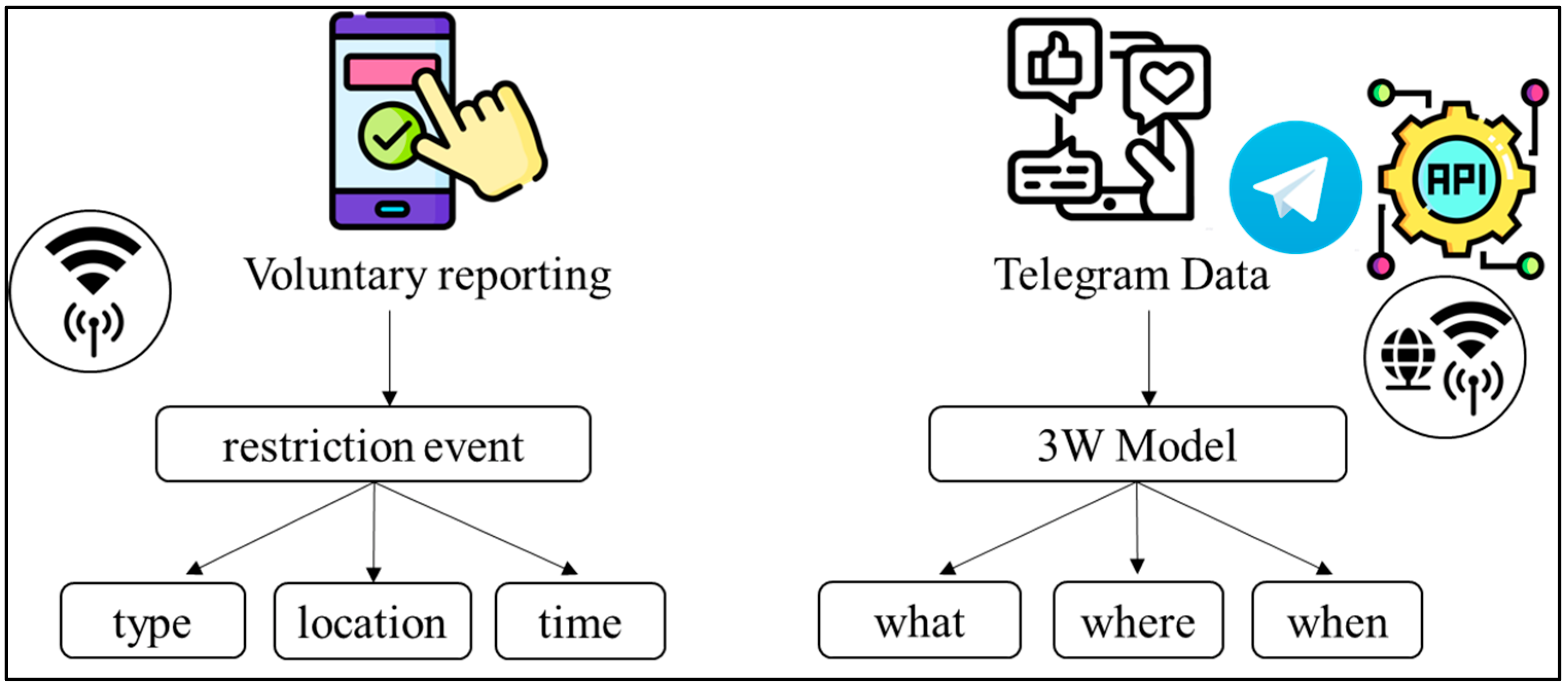
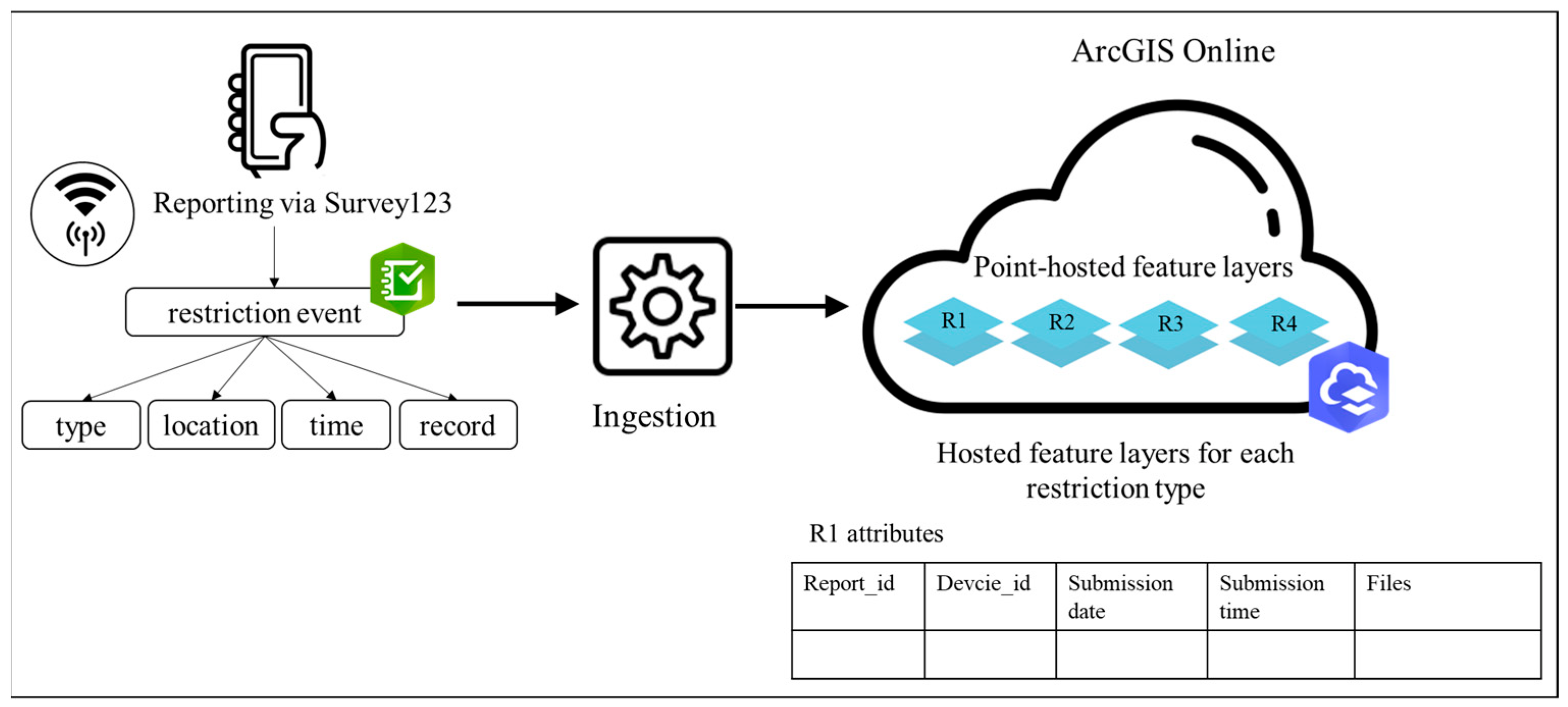




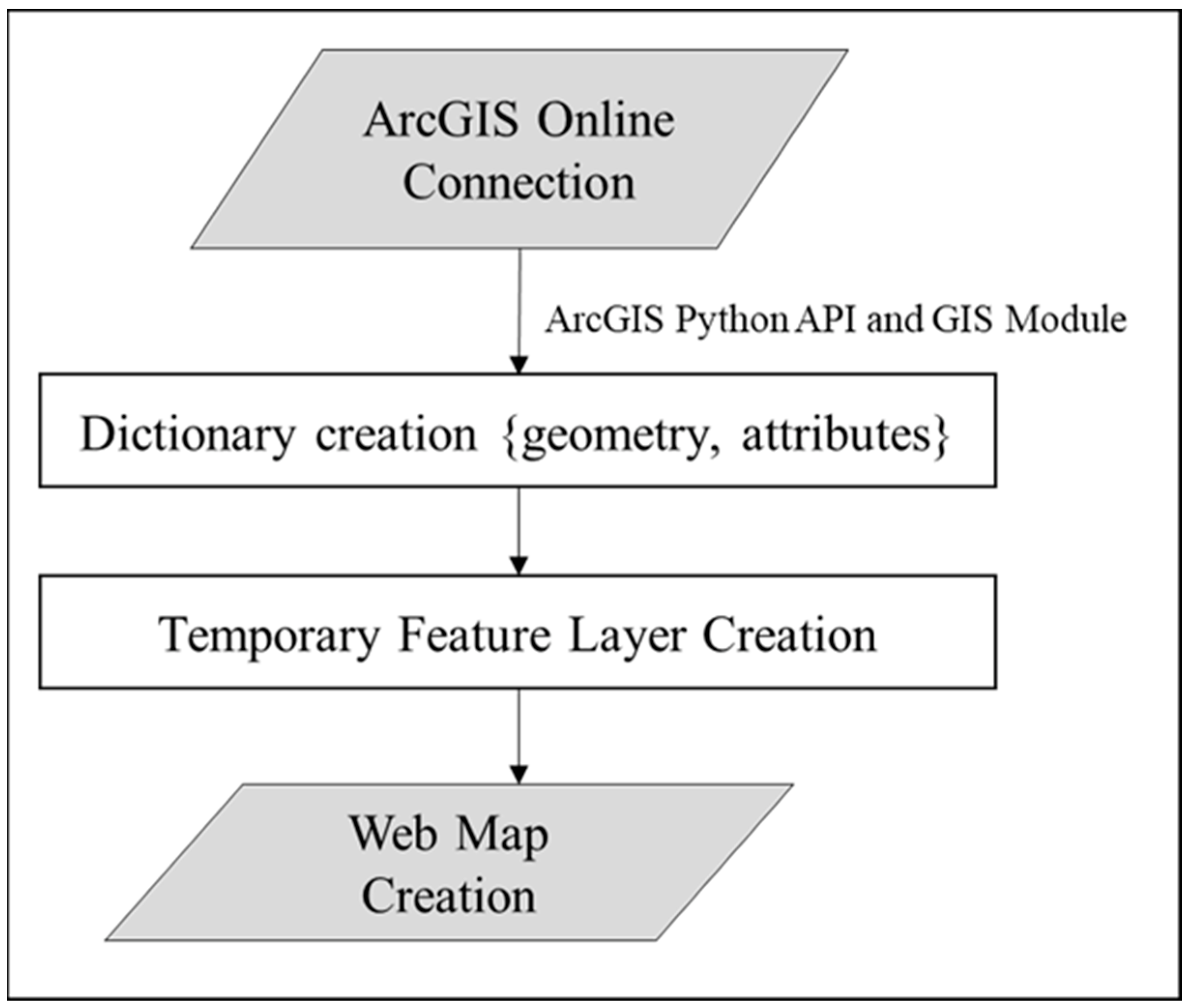
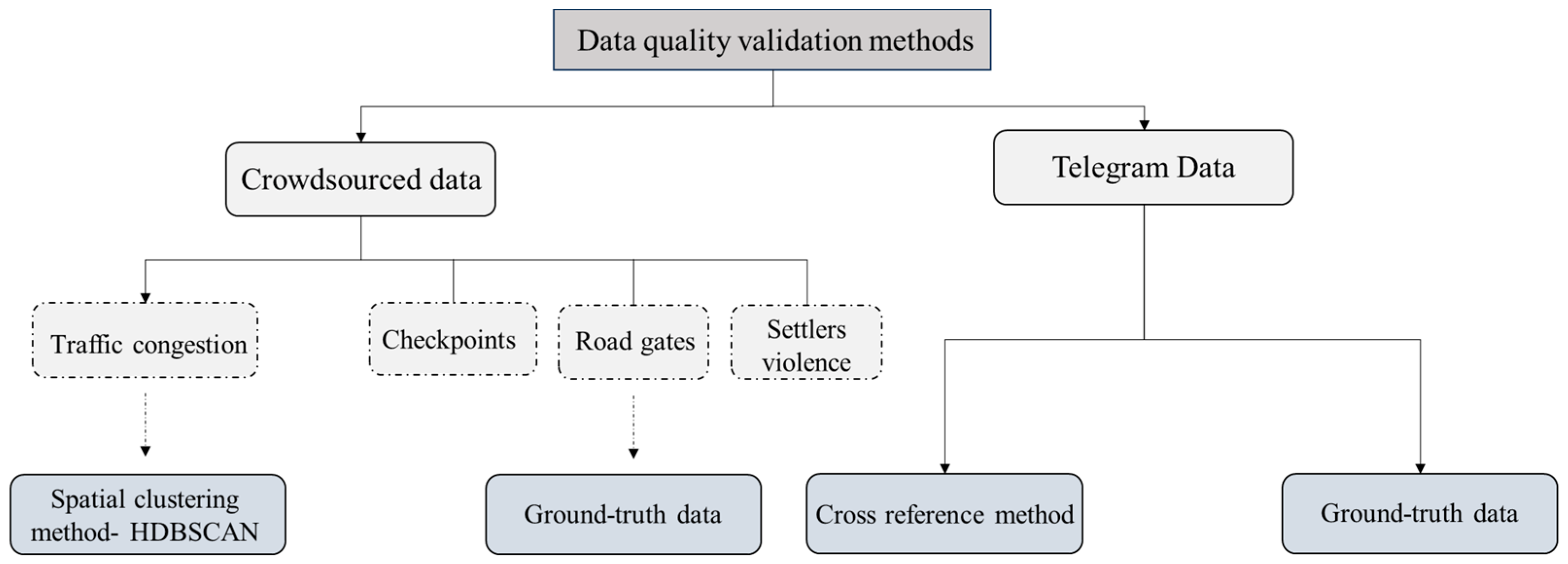
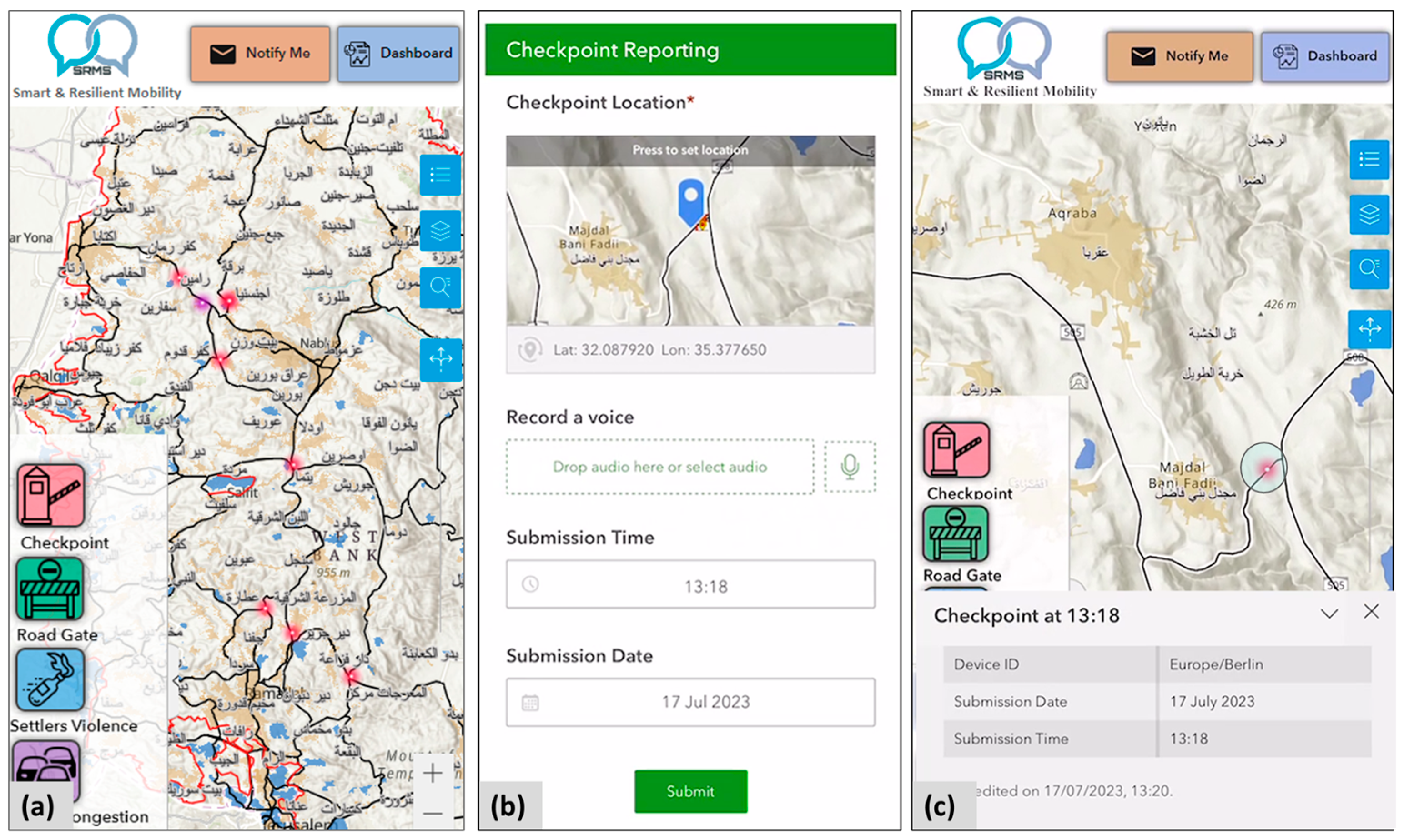


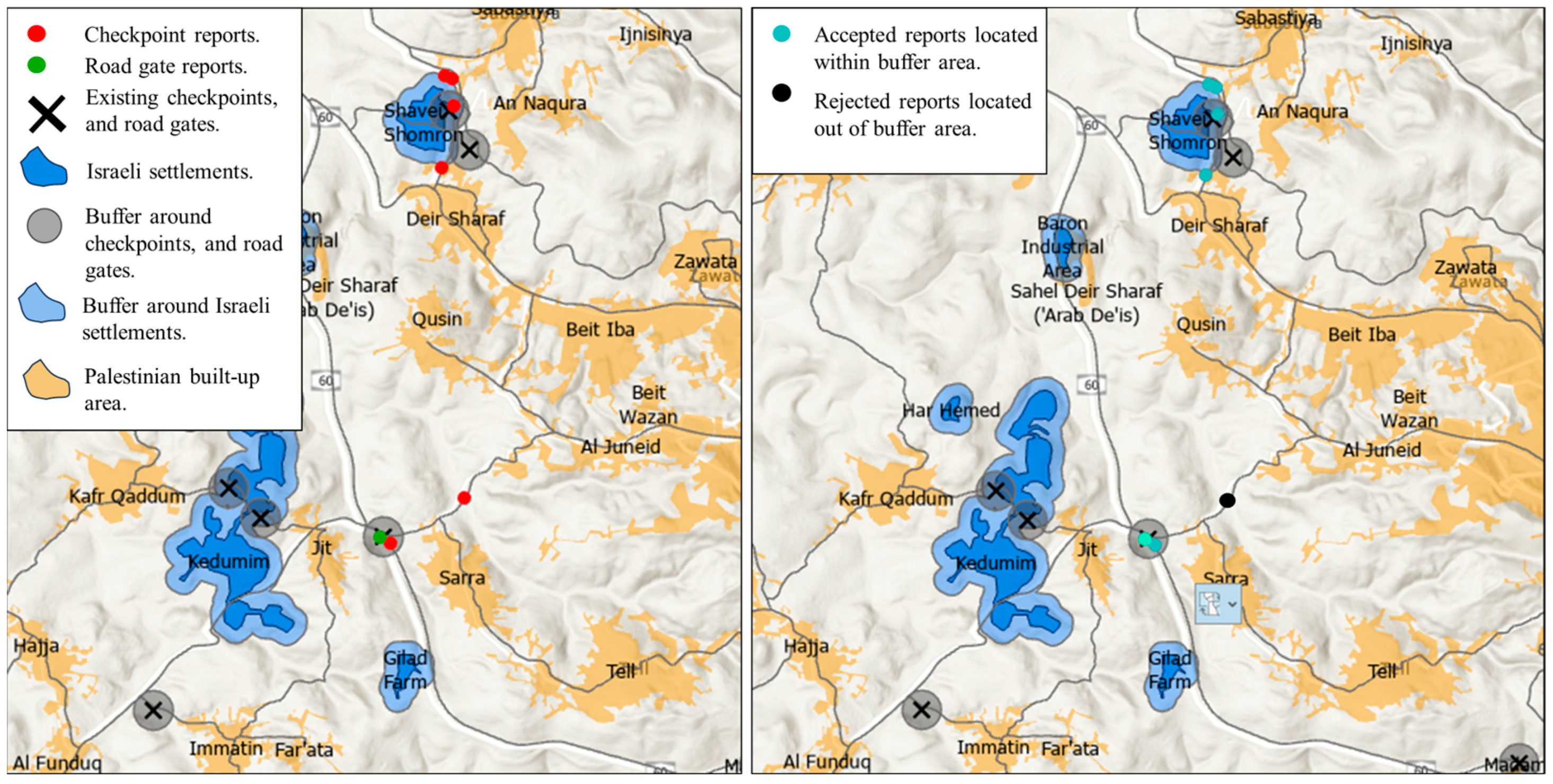


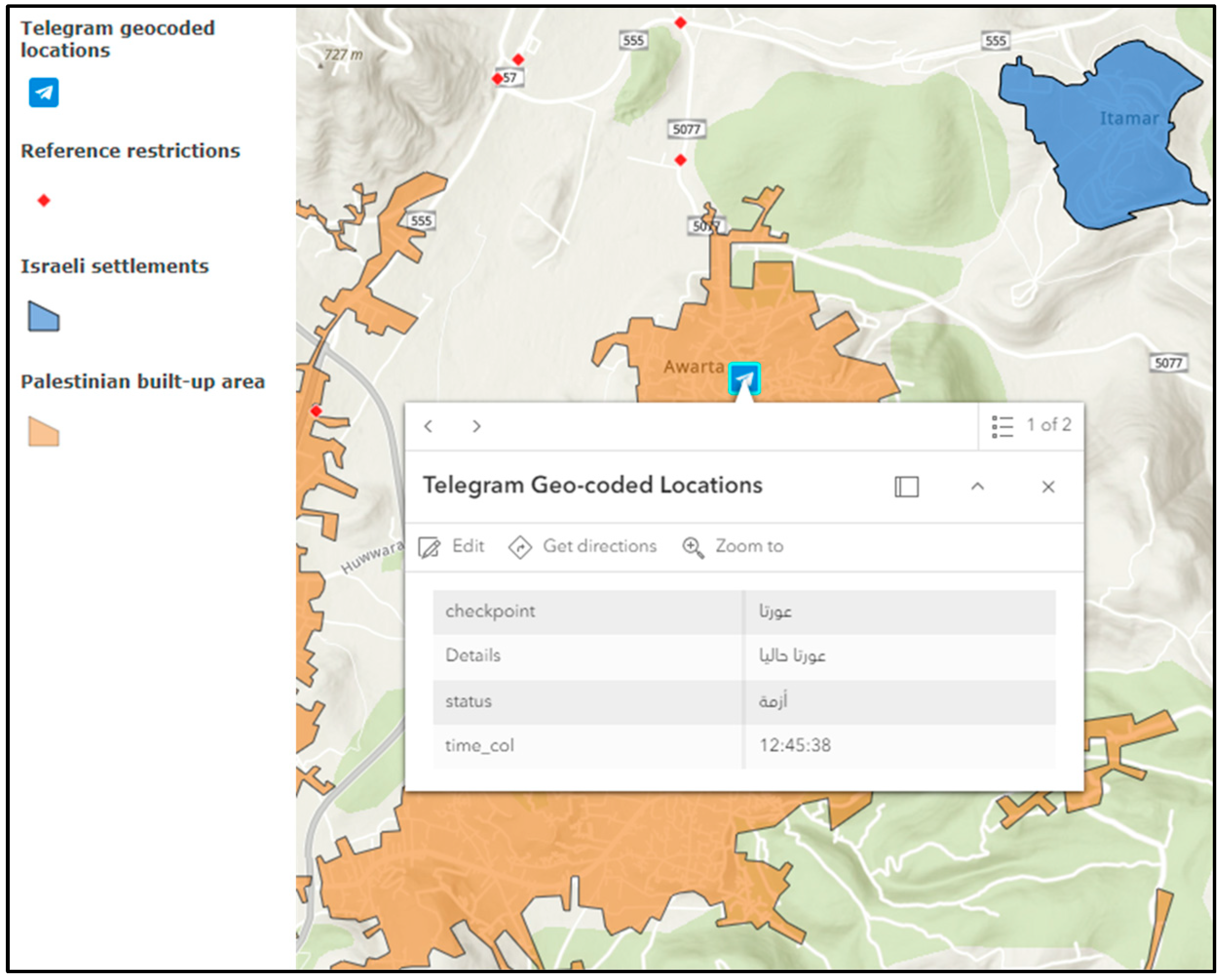
| Keywords of Restriction Status | Palestinian DA | MSA | ||
|---|---|---|---|---|
| Open | سالك | Salik | مفتوح | Maftouh |
| سالكة، سالكه | Salikah | |||
| Closed | مسكر | msakir | مغلق | Mughlaq |
| مسكره، مسكرة | msakireh | مغلقة، مغلقه | Mughlaquh | |
| إغلاق، اغلاق | Ighlaq | |||
| شبه مغلق | hibh mughlaq | |||
| شبه مغلقة، شبه مغلقه | hibh mughlaq | |||
| Congested | مأزم، مازم | ma’azim | أزمة، ازمة | Azima |
| سيئ | sayie’ | |||
| سيئة، سيئه | sayie’a | |||
| Violent incidents | مواجهات | Muwajahat | ||
| مستوطنين | Mustawtinin | |||
| مسلحين | Musalahin | |||
Disclaimer/Publisher’s Note: The statements, opinions and data contained in all publications are solely those of the individual author(s) and contributor(s) and not of MDPI and/or the editor(s). MDPI and/or the editor(s) disclaim responsibility for any injury to people or property resulting from any ideas, methods, instructions or products referred to in the content. |
© 2024 by the authors. Licensee MDPI, Basel, Switzerland. This article is an open access article distributed under the terms and conditions of the Creative Commons Attribution (CC BY) license (https://creativecommons.org/licenses/by/4.0/).
Share and Cite
Aburas, H.; Shahrour, I.; Sadek, M. Leveraging Crowdsourcing for Mapping Mobility Restrictions in Data-Limited Regions. Smart Cities 2024, 7, 2572-2593. https://doi.org/10.3390/smartcities7050100
Aburas H, Shahrour I, Sadek M. Leveraging Crowdsourcing for Mapping Mobility Restrictions in Data-Limited Regions. Smart Cities. 2024; 7(5):2572-2593. https://doi.org/10.3390/smartcities7050100
Chicago/Turabian StyleAburas, Hala, Isam Shahrour, and Marwan Sadek. 2024. "Leveraging Crowdsourcing for Mapping Mobility Restrictions in Data-Limited Regions" Smart Cities 7, no. 5: 2572-2593. https://doi.org/10.3390/smartcities7050100







